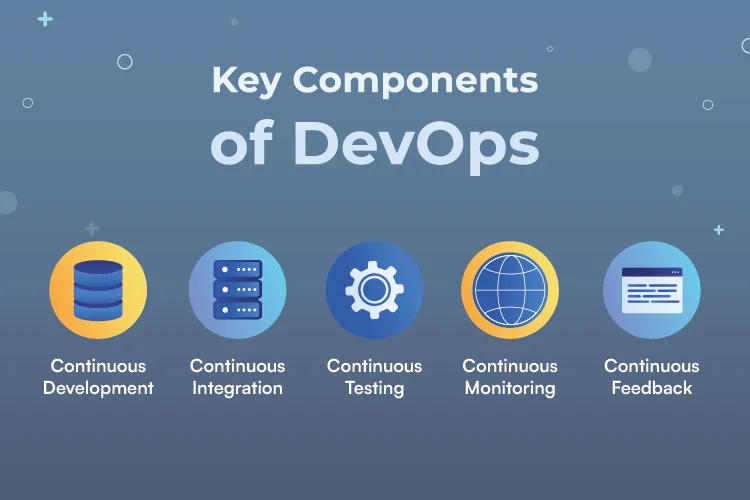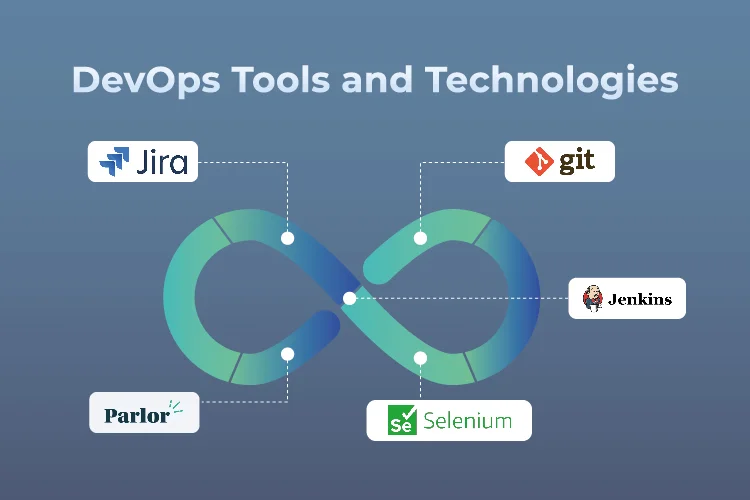The word DevOps arose in this constantly evolving landscape, mostly of software development and IT operations. Understanding the requirement for development and operations, including testing, monitoring, and automation, are the major components of DevOps.
While DevOps has been around for a while, the concept is still gaining traction and reshaping how firms deploy software and manage their IT infrastructure. This blog will embark on a journey to deconstruct DevOps, revealing its primary stages of the DevOps Lifecycle, practices, and why it has become an essential component of modern technological ecosystems.
What is DevOps?
The tight link between the words “Dev” and “Ops” defines the primary stages of the DevOps Lifecycle. Starting with software analysis, moving on to planning to define the codebase, building the application, end-to-end testing, and finally the product release phases, as well as deployment, operations, and continuing software monitoring.
The combination of these two, on the other hand, accelerates drives to the seamless continuous customer feedback loop for continuous development, improvement, testing, and deployment. Thus, the result of these key components of DevOps might be a highly rapid, continuous release of necessary feature updates or additions based on the client’s product’s commercial aspects and overall success.
DevOps is also characterized as a sequence of development and IT operations with improved communication. DevOps has become one of the most valuable business disciplines for organizations, and it has greatly enhanced the quality and speed of application delivery.
Finally, DevOps is about integrating the development and operation processes. DevOps-adopted organizations saw a 22% improvement in software quality, a 17% increase in application deployment frequency, and a 22% increase in customer satisfaction. Revenue increases by 19% because of successful DevOps deployment.
DevOps Life Cycle:
DevOps Lifecycle is a methodology used by software development developers to bring products to market faster and more efficiently. It is a method of managing the complete software lifecycle, from the development stage to release, with an emphasis on collaboration between developers and IT operations personnel.
As a result, DevOps adoption strategies promote creative thinking, speed, and agility in the production, verification, use, and development of software systems. To reinvent goods, services, and operations, a spirit of invention, evaluation, and continual improvement is encouraged.
Let’s have a look at how the DevOps lifecycle works at each stage.
- Plan: The initial phase in DevOps in which professionals determine and obtain end-user feedback. In this step, developers create a project plan to maximize commercial effects and generate the desired result.
- Code: After creating a plan, we begin constructing the code. To make the design process easier, developers use DevOps tools like Git, which help them avoid safety issues and poor coding standards.
- Build: Once developers have done their assignment, they use tools such as Maven and Gradle to submit the developed code to a central code repository.
- Test: To ensure software integrity, the product is first given to the test platform, where various types of screening such as user acceptability testing, safety testing, integration checking, speed testing, and so on are performed using tools such as Junit and Selenium.
- Release: The product is now ready to be deployed in the operational environment. When the application passes all checks based on organizational requirements, the DevOps department prepares updates or delivers multiple versions to production.
- Deploy: At this point, Infrastructure-as-Code supports the creation of operational infrastructure before publishing the product utilizing various DevOps lifecycle tools.
- Operate: This version is now easier for users to use. At this phase, the management department handles server configuration and deployment using tools such as Chef.
- Monitor: At this stage, the DevOps workflow is observed based on data received from user behavior, application efficiency, and other sources. The ability to see the entire environment assists teams in identifying bottlenecks influencing the performance of the production and operations teams.
Key Components of DevOps:

The key components of DevOps that create the DevOps life cycle and make the software development process flow more smoothly and securely are listed below.
- Continuous Development: Development is the most important aspect of DevOps. The team probes the objectives that must be supplied through the application, and once the objectives are decided, the coding development process begins. It moves on to the next level after development. Because DevOps practices continuous development, it also works on earlier applications to make modifications based on feedback and to meet requirements.
- Continuous Integration: The team moves from the continuous development process to the continuous integration phase, where they plan various tests for the next phase. Integration aids in determining whether or not the developed application fits the desired requirements. As a result, continuous integration is an inefficient procedure that leads to the next phase.
- Continuous Testing: The developed application is tested using automation tools at this phase. The testing team tests the applications using numerous test cases and provides results on various elements of the program. Following that, the development team receives the results and uses them to improve the application’s quality.
- Continuous Monitoring: Continuous monitoring allows for the discovery of areas of contention that require further investigation and development to improve the application’s performance. Throughout the DevOps lifecycle, monitoring is performed. The development team closely monitors and record applications using tools such as Splunk, ELK Stack, Nagios, and others. These discover problems and notify the development team so that they can be resolved. As a result, this phase of the life cycle will prioritize excellent performance and service uptime.
- Continuous Feedback: Finally, by reviewing the results of all of the preceding processes, the application may be continuously improved. This continuous feedback phase is critical in the DevOps life cycle because it gives feedback on the application after it has been developed but before it is delivered to clients. As a result, it is simple to eliminate faults and improve the application’s efficiency.
Why DevOps Matters?
In today’s competitive software industry, automation and artificial intelligence (AI) play critical roles, and to stay ahead of the competition and attract stakeholders and customers, we must convert and adapt DevOps “best practices.” So, why do you require DevOps in the first place?
Here are the reasons to adopt DevOps:
- To remain competitive in a market where others are already doing so.
- To boost team velocity as well as product delivery.
- Update the adjustments on the manufacturing line as soon as possible to minimize downtime.
- To reduce human mistakes, all tasks should be mechanized.
DevOps Tools and Technologies:

Here are some of the popularly DevOps tools and technologies, used in different stages of DevOps:
- Jira: Although no DevOps technologies are expressly required for planning, Jira and other Agile project management tools are commonly utilized in DevOps firms. The Jira DevOps template can help you organize workflows, manage projects, and keep track of problems.
- Git: Git is an open-source version management system that is free to use. It is an excellent DevOps tool because it promotes developer collaboration and nonlinear processes. You may connect development and operations with the help of GitHub, a web-based hosting platform for Git code repositories.
- Jenkins: Jenkins is a Java open-source application. It can act solely as a continuous integration server or as a continuous delivery center. Jenkins is well-known for a variety of plugins and integrations, ease of installation, the ability to effectively split work over many workstations for cross-platform development, and full workflow customization.
- Selenium: It is another open-source development tool. It is an automated testing framework that allows the production of test scripts in common programming languages such as Java, Python, and C#. Selenium’s versatility allows it to provide automation support for a wide range of browsers and operating systems (OS).
- Parlor: Parlor is a user relationship management tool that collects customer feedback. It communicates with active users in real time to acquire contextual knowledge. It interfaces with corporate applications such as Excel data management programs, Jira technical task management systems, Slack communication tools, and ZenDesk support ticket systems.
Such DevOps tools and technologies are beneficial at all stages of DevOps, allowing for testing, monitoring, feedback collection, and other activities. These have been deliberately picked for each DevOps to function flawlessly while introducing new and innovative software development.




